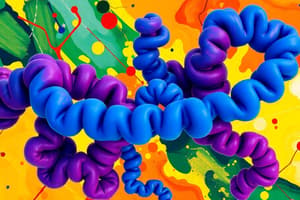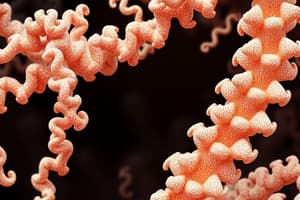Podcast
Questions and Answers
What is a common consequence of misfolded proteins in biological systems?
What is a common consequence of misfolded proteins in biological systems?
- Deterioration of cellular environments. (correct)
- Increased protein synthesis.
- Enhanced enzyme activity.
- Improved protein interactions.
Which factor is most likely to lead to the necessity for molecular chaperones?
Which factor is most likely to lead to the necessity for molecular chaperones?
- Complex or large proteins with kinetic interference. (correct)
- Sporadic genes expression levels.
- The presence of small, non-functional peptides.
- Reduced amino acid availability.
How do molecular chaperones assist in protein folding?
How do molecular chaperones assist in protein folding?
- By preventing protein degradation.
- By providing an environment for proper conformation. (correct)
- By increasing the rate of protein synthesis.
- By promoting spontaneous folding.
What is a potential result when there is dysfunction in a molecular chaperone?
What is a potential result when there is dysfunction in a molecular chaperone?
Which of the following best describes a prion-related disease mechanism?
Which of the following best describes a prion-related disease mechanism?
What role do chaperones play in protein folding?
What role do chaperones play in protein folding?
What can result from protein aggregation?
What can result from protein aggregation?
What is a consequence of prion misfolding?
What is a consequence of prion misfolding?
Which of the following accurately describes a fibril?
Which of the following accurately describes a fibril?
How can aging influence protein aggregation?
How can aging influence protein aggregation?
What is the result of the overexpression of certain proteins?
What is the result of the overexpression of certain proteins?
What characterizes transmissible spongiform encephalopathies?
What characterizes transmissible spongiform encephalopathies?
What is a characteristic of sporadic spongiform encephalopathies?
What is a characteristic of sporadic spongiform encephalopathies?
Which post-translational modification is indicated as influencing the activity of proteins like RELA?
Which post-translational modification is indicated as influencing the activity of proteins like RELA?
What is the main cause of misfolding in proteins, as discussed in the context of ALS and Alzheimer's disease?
What is the main cause of misfolding in proteins, as discussed in the context of ALS and Alzheimer's disease?
Which of the following statements about genetic spongiform encephalopathies is true?
Which of the following statements about genetic spongiform encephalopathies is true?
Which of the following best describes the role of protein modifications in biochemical pathways?
Which of the following best describes the role of protein modifications in biochemical pathways?
What common feature is shared by prion diseases?
What common feature is shared by prion diseases?
How do post-translational modifications like methylation and phosphorylation interact in terms of protein function?
How do post-translational modifications like methylation and phosphorylation interact in terms of protein function?
What percentage of spongiform encephalopathy cases are attributed to acquired factors?
What percentage of spongiform encephalopathy cases are attributed to acquired factors?
What is one primary consequence of protein misfolding related to infectious-like behavior?
What is one primary consequence of protein misfolding related to infectious-like behavior?
Which process is essential for creating a functional protein from a string of amino acids?
Which process is essential for creating a functional protein from a string of amino acids?
What type of proteins are typically unable to achieve their native conformations and can lead to aggregation?
What type of proteins are typically unable to achieve their native conformations and can lead to aggregation?
How are prokaryotic protein aggregates predominantly characterized?
How are prokaryotic protein aggregates predominantly characterized?
What are prions primarily classified as?
What are prions primarily classified as?
Which disease is associated with proteins that exhibit prion-like behavior?
Which disease is associated with proteins that exhibit prion-like behavior?
Which of the following best describes the most common form of prion disease?
Which of the following best describes the most common form of prion disease?
In the context of protein structure, what outcome occurs when a protein cannot fold properly?
In the context of protein structure, what outcome occurs when a protein cannot fold properly?
What is a significant clinical implication of protein aggregation in neurodegenerative diseases?
What is a significant clinical implication of protein aggregation in neurodegenerative diseases?
What percentage of prion disease cases are typically considered sporadic?
What percentage of prion disease cases are typically considered sporadic?
Which of the following modifications can contribute to making proteins active?
Which of the following modifications can contribute to making proteins active?
What mechanism is primarily associated with prion-like infectious behavior in misfolded proteins?
What mechanism is primarily associated with prion-like infectious behavior in misfolded proteins?
What is the primary role of molecular chaperones in protein folding?
What is the primary role of molecular chaperones in protein folding?
Which of the following post-translational modifications is primarily involved in adding hydroxyl groups to proteins?
Which of the following post-translational modifications is primarily involved in adding hydroxyl groups to proteins?
What consequence can result from protein aggregation related to cellular function?
What consequence can result from protein aggregation related to cellular function?
In the context of prion diseases, what is a key feature that differentiates prions from other proteins?
In the context of prion diseases, what is a key feature that differentiates prions from other proteins?
Which type of post-translational modification can either activate or inactivate protein function?
Which type of post-translational modification can either activate or inactivate protein function?
What is the relationship between protein misfolding and the function of molecular chaperones?
What is the relationship between protein misfolding and the function of molecular chaperones?
What type of post-translational modification involves the addition of sugar molecules?
What type of post-translational modification involves the addition of sugar molecules?
How can disruption of molecular chaperones contribute to disease?
How can disruption of molecular chaperones contribute to disease?
Which post-translational modification can lead to the degradation of proteins?
Which post-translational modification can lead to the degradation of proteins?
Flashcards
Protein Aggregation
Protein Aggregation
The clustering of misfolded proteins into large clumps.
Misfolded Proteins
Misfolded Proteins
Proteins that have incorrect 3-D shapes.
Creon Stage
Creon Stage
When misfolded proteins cause more misfolding.
Prion
Prion
Signup and view all the flashcards
Fibril
Fibril
Signup and view all the flashcards
Transmissible Spongiform Encephalopathies
Transmissible Spongiform Encephalopathies
Signup and view all the flashcards
Protein Chaperones
Protein Chaperones
Signup and view all the flashcards
Protein Folding
Protein Folding
Signup and view all the flashcards
Aggregation Problems
Aggregation Problems
Signup and view all the flashcards
Cellular Function
Cellular Function
Signup and view all the flashcards
Neurodegenerative Diseases
Neurodegenerative Diseases
Signup and view all the flashcards
Misfolding Proteins
Misfolding Proteins
Signup and view all the flashcards
Spongiform Encephalopathies
Spongiform Encephalopathies
Signup and view all the flashcards
Sporadic Spongiform Encephalopathy
Sporadic Spongiform Encephalopathy
Signup and view all the flashcards
Genetic Spongiform Encephalopathy
Genetic Spongiform Encephalopathy
Signup and view all the flashcards
Acquired Spongiform Encephalopathy
Acquired Spongiform Encephalopathy
Signup and view all the flashcards
Protein Misfolding
Protein Misfolding
Signup and view all the flashcards
Protein Modifications
Protein Modifications
Signup and view all the flashcards
Biochemical Pathways
Biochemical Pathways
Signup and view all the flashcards
RELA Modification
RELA Modification
Signup and view all the flashcards
Methylation
Methylation
Signup and view all the flashcards
Phosphorylation
Phosphorylation
Signup and view all the flashcards
Spontaneous Protein Folding
Spontaneous Protein Folding
Signup and view all the flashcards
Non-spontaneous Protein Folding
Non-spontaneous Protein Folding
Signup and view all the flashcards
Kinetic Interference
Kinetic Interference
Signup and view all the flashcards
Misfolded Protein
Misfolded Protein
Signup and view all the flashcards
Molecular Chaperones
Molecular Chaperones
Signup and view all the flashcards
Protein Aggregation
Protein Aggregation
Signup and view all the flashcards
ALS (Amyotrophic Lateral Sclerosis)
ALS (Amyotrophic Lateral Sclerosis)
Signup and view all the flashcards
Tertiary Structure
Tertiary Structure
Signup and view all the flashcards
Misfolded proteins
Misfolded proteins
Signup and view all the flashcards
Protein aggregation
Protein aggregation
Signup and view all the flashcards
Prions
Prions
Signup and view all the flashcards
Prion diseases
Prion diseases
Signup and view all the flashcards
Spongiform encephalopathies
Spongiform encephalopathies
Signup and view all the flashcards
Sporadic diseases
Sporadic diseases
Signup and view all the flashcards
Genetic diseases
Genetic diseases
Signup and view all the flashcards
Acquired diseases
Acquired diseases
Signup and view all the flashcards
ALS(Amyotrophic Lateral Sclerosis)
ALS(Amyotrophic Lateral Sclerosis)
Signup and view all the flashcards
Protein modifications
Protein modifications
Signup and view all the flashcards
Protein structure and function link
Protein structure and function link
Signup and view all the flashcards
Post-translational Modification
Post-translational Modification
Signup and view all the flashcards
Protein Aggregation
Protein Aggregation
Signup and view all the flashcards
Molecular Chaperone
Molecular Chaperone
Signup and view all the flashcards
Phosphorylation
Phosphorylation
Signup and view all the flashcards
Hydroxylation
Hydroxylation
Signup and view all the flashcards
Protein Folding
Protein Folding
Signup and view all the flashcards
Tertiary Structure
Tertiary Structure
Signup and view all the flashcards
Protein Function
Protein Function
Signup and view all the flashcards
Prion
Prion
Signup and view all the flashcards
Kinase
Kinase
Signup and view all the flashcards
Phosphate
Phosphate
Signup and view all the flashcards
Disulfide Bond
Disulfide Bond
Signup and view all the flashcards
Spontaneous Folding
Spontaneous Folding
Signup and view all the flashcards
Study Notes
Protein Modifications
- Proteins are regulated by modifications, including transcription, translation, and post-translational modifications.
- Post-translational modifications include addition or removal of functional groups (e.g., phosphorylation, hydroxylation, sulfation, acetylation, lipidation, methylation, glycosylation, ubiquitylation).
- Phosphorylation is a common, reversible modification, with kinases adding phosphate groups and phosphatases removing them.
- Protein function depends on proper folding.
- Modifications can affect protein folding, and misfolding can lead to aggregation and disease.
Protein Folding
- Folding can be spontaneous or require molecular chaperones.
- Molecular chaperones assist folding, ensuring proteins acquire correct 3D structures.
- Domains and regions within proteins interact, enabling folding.
- Kinetic interference can hinder or slow down spontaneous folding.
- Misfolded proteins can aggregate, forming aggregates or fibrils.
Protein Aggregation
- Protein aggregation is the accumulation of misfolded proteins.
- Aggregates can clog processes, interfere with transport, and contribute to diseases (Creutzfeldt-Jakob disease, Alzheimer's etc).
- Misfolded protein can cause further misfolding (prions).
- Chaperones prevent protein aggregation.
- Improper folding can lead to toxic buildup.
Spongiform Encephalopathies
- Spongiform encephalopathies are caused by misfolded proteins forming aggregates and fibrils.
- Types include sporadic, genetic, and acquired.
- These diseases have progressive symptoms that are often fatal, with a short life expectancy (e.g., less than six months).
- Modifcations are crucial components in protein function.
Studying That Suits You
Use AI to generate personalized quizzes and flashcards to suit your learning preferences.





